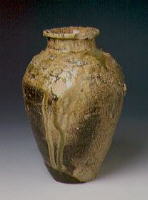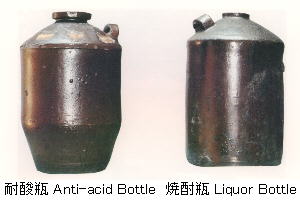Chronological Table of Tokoname ceramic history

1100 Ana-gamas(hole kiln) for ceramics are built all over
the Chita peninsula. Tokoname ware begins.
1150 Jars made in Tokoname begin to be used for the storage
of sutras in many places in Japan.
1180 Pots and jars from Tokoname are used in great volume
in major cities such as Kyoto and Hiraizumi in the
Tohoku region.
1200 Old Tokoname ware is at its peak.(Tokoname ware has
been excavated in many sites in Japan as far away as
Kamakura.)
*1215 Magna Carta issued, under duress, by King John of
England.
*1337 Hundred Years' War, waged by England against France,
begins.
1400 Kilns in the Chita peninsula are concentrated in the
Tokoname area.
The change from the anagama(hole kiln) to the ogama
(large kiln) begins.
*1492 Christopher Columbus lands in the Bahamas.
*1517 Martin Luther nails the Ninety-five
Theses to the church door at Wittenberg.
1600 Earthenwear (Akamono) appears in addition to unglazed
stoneware (Mayakemono).
*1600 British East India Company incorporated by royal charter.
*1602 Dutch government grants the Dutch East India Company
on trade in the East Indies.
1694 Tokoname has twelve large kilns in operation.
1700 Jars made in Tokoname are used as coffins in the Edo era.
1750 Yahei Watanabe is given the name, "Genkosai", from the
lord of Owari. He starts to engrave his name on his ceramics.
1775 The lord of Owari visits Tokoname and observes the jar
making technique of two craftsmen on the way to Ono for salt
bathing.
*1776 Continental Congress issues the US Declaration of Independence.
*1789 George Washington becomes the first president of the United States.
French Revolution begins
1797 Tea master, Kagyu Tenmaya living in Nagoya asks Choza Ina I and
Tozen Akai who live in Tokoname to make tea wares suited to his taste.
*1804 Napoleon crowns himself emperor of France.
1811 The head of the Kyoto Hisada school of tea ceremony, Koho Hanshoan,
visits Tokoname and makes water jars for the tea ceremony.
1825 Uemura Hakuho vvhose works represent Tokoname ceramics in the
Edo era makes black raku tea bowls in the house of the Konoe
family in Kyoto.
1830 Choza Ina II invents whiteware made of white clay and Mogake
design on whiteware which uses seaweed as glazing. Sanko
Matsushita produces "Nanban-utsushi".
1834 A climbing kiln with various chambers
is made by Hokyo Koie.
*1837 Victoria becomes queen of England.
*1839 Opium War begins in China
1847 Hoju Koie produces stoneware ceramic pipes for water
services.
Unglazed pipes produced for agricultural purposes.
1848 When the twelfth lord of Owari visits Chita area,
Choza Ina II, Takamichi Inaba II, Sanko Matsushita I
and Thozen Akai II perform their pottery technique
before him.
1854 Jyumon Sugie succeeds in producing redware. Niko
Kataoka also takes part in it.
1857 Kyuemon Matsumoto prints advertisement in woodblock
depicting the excellent quality of Tokoname stoneware.
*1861 Civil War begins in the United States.
1873 Hoju Koie succeeds in the mass production of modern
ceramic pipes using wooden molds. They are used for
sewerage in the foreign settlement in Yokohama.
1878 Hoju Koie invites Jin Shi Heng to teach teapot making
techniques and Giyu Ware decoration to Tokoname potters
such as Jumon Sugie, Choza Ina IV and Hakusai Isomura.
1879 Takashi Koie makes ceramics decorated with various
bright colors (Kinrande-toki) for export.
1883 Tokoname Art Institute is established. Yozo Naito and
Shinichi Terauchi who studied with an Italian sculptor,
Vincenzo Ragusa, become teachers and teach Western sculpture.
1885 The production of liquor bottles begins.

1887 The production of "Shudei-tatsumaki" booms. Exporting
systems established.
1889 "Kokudeiyaki" blackware is introduced by Hakusai Isomura.
1896 Tokoname Industrial School opens.
Modern ceramic education flourishes.
Ceramic pipes are made by machine.
*1896 First modern Olympic games held at Athens.
1899 The production of ceramic pipes for the conductor of
underground telephone wires starts.
1900 Down-draft kilns fired by coal are introduced.
1901 Salt glazing starts in coal fired kilns.
1905 Noborigama is improved to use coal and wood as a source
of fuel.
1907 The Tokoname Trade Association opens a research laboratory
to improve throwing technique and glazing. The production
of ink bottles becomes a major ceramic item.
1909 Tokoname-made terracotta is used for Kyoto Prefectural Library.
1910 Ina Seitosho produces mosaic tiles.
1911 There are 22 kilns and 76 climbing and coal fired kilns
in Tokoname.
*1914 Panama Canal completed.
World War I begins.
1915 The ceramic statue of Hoju Koie is made by Rokuro Hirano.
1917 The factory to produce the terracotta for the Imperial
Hotel opens in Tokoname.
1918 Biscuit fired ware with Japanese lacquer is invented.
1921 The reproduction of Rockingham ware is exported.
1925 Yonan Inoue, one of the famous potters in the Taisho era
wins the "Grand Prix" at the Exposition International
des Arts decoratifs et Industriels Moderns in Paris.
1930 Tokoname Pottery Hall opens. "Tokoname Toki Kan"
*1933 Adolf Hitler becomes chancellor of Germany.
1934 Tunnel kilns are introduced.
1935 Bernard Leach visits Tokoname.
1938 The production of European style white colored toilets
starts. Green and brown colored toilets had been produced
since the Meiji era.
*1939 World War2 begins in Europe.
1944 The production of Ro-go anti-acid stoneware starts.
*1945 World War 2 ends.
1951 Heavy oil fired square kilns start to be used.
1952 The Tokoname Old Kiln Research Association is organized.
The artistic appreciation of Old Tokoname ware gains
wide acceptance.
1955 Sakuzo Hineno starts to teach craft design to
manufacturers and potters.
1958 Electric kilns are introduced.
1960 Shuttle kilns are introduced. Ishei Ozaki makes replicas
of Old Tokoname ware.
1961 The Ceramic Art Institute opens.
*1965 US airplanes begin bombing North Vietnam.
*1966 Cultural Revolution sweeps across China.
1968 The Tokoname Ceramic Technology Center opens.
Avant-garde ceramics starts in Tokoname.
1970 Ceramic benches are displayed in the Japanese garden
at the Osaka Exposition. The Tokoname art group
"Tokoname zokei shudan" is organized.
Tokoname Ceramic Hall opens to replace Tokoname Pottery Hall.
1972 Choza award for potters starts.
Tokoname potters group wins the "Grand Prix" at the third
Biennale Internationale de Creamique D'art in Vallauris, France.
1985 The International Workshop of Ceramic Art in Tokoname starts.
*1989 Tianamen Square Incident.
*1990 Reunification of Germany.
*1991 Soviet Union dissolved.

